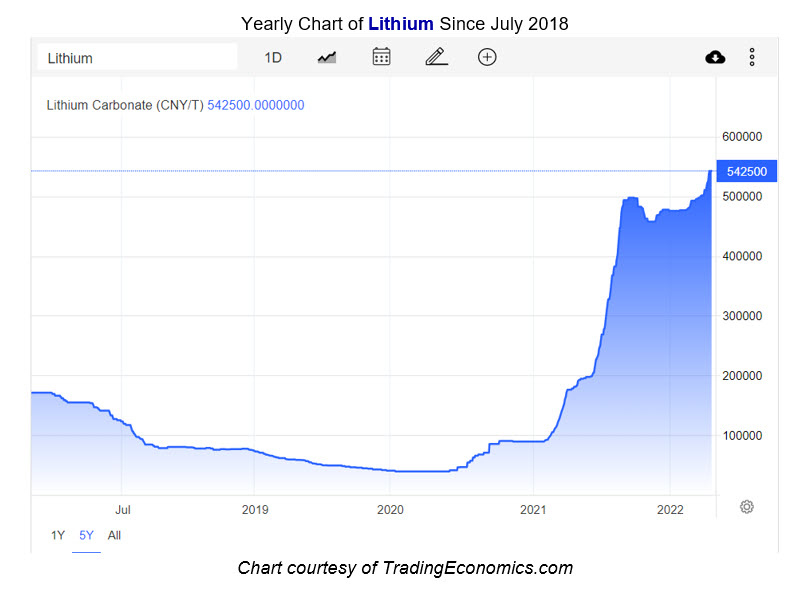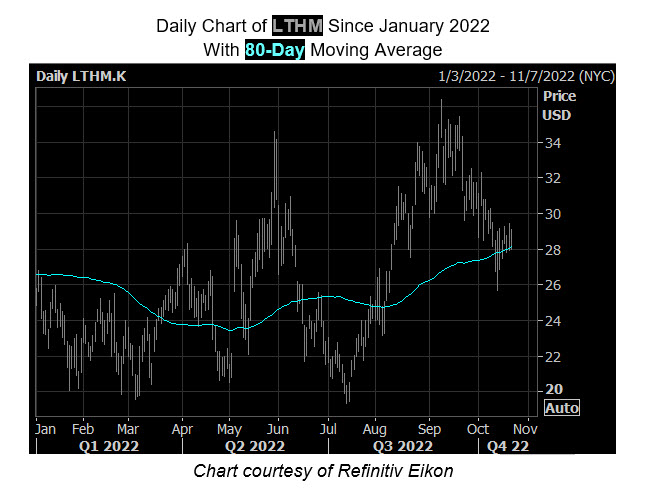The Biden administration awarded $2.8 billion in grants to increase the United States’ stable of electric vehicle (EV) batteries and the minerals used to create them, a transparent countermeasure to reduce China’s chokehold on materials integral to clean energy, notes Patrick Martin, an analyst with Bernie Schaeffer's Chart of the Week.
Lithium, graphite, and nickel will all see large-scale processing stateside now, with 20 companies receiving the grants. This was an unequivocal win for the EV industry, where lithium mining is integral to scaling the supply of batteries that power EVs. Where does this development leave the lithium industry, a segment of mining regarded by some as the next gold rush?
The Department of Energy (DoE) didn’t specify which companies received the grant, but Albemarle (ALB) put some of the speculation to rest by announcing it had been awarded nearly $150 million. Piedmont Lithium (PLL) put out a newswire not long after announcing it had collected $141.7 million. ALB and PLL are up 15% and 48% in the last three months, respectively, the latter tacking on 12.2% Wednesday when the news of the grant first broke.
Elon Musk announced on its latest earnings conference call that Tesla (TSLA) was poised to build a lithium refinery on the Texas gulf coast. This is all great news for the companies and the jobs they’ll create, but what about the price of lithium?
It’s difficult to ascertain because lithium doesn’t have a futures market. Lithium carbonate in China, per the chart below, remains at all-time highs, last seen at 542,500 yuan, or just under $75,00 a ton. That benchmark is up about 200% over the past 12 months and up roughly 12-fold compared with late 2020.

That’s only one form of the metal. There’s also lithium hydroxide, which has a cash-settled futures contract on the London Metal Exchange (LME), based on the weekly physical spot price in China, Japan, and Korea. But since you can’t just call up your broker and trade the metal, you have to rely on lithium exploration stocks, and there’s a strictly speculative nature to those specific miners.
While demand for the metal will most likely skyrocket in the next five years, many of these mining companies’ profit margins will remain a mystery and untethered to lithium’s price, as long as they remain tied to the electric vehicle rush. One thing is for sure; there’s plenty of lithium to be mined from the earth’s crust and it’s exciting to see the U.S. join the “white gold” rush.
Biden’s move to ween the U.S. off lithium from China is astute, but investors should also be monitoring Australia, as well as Bolivia, Chile, and Argentina. The latter ‘Lithium Triangle’ in South America contains over half of the world’s known lithium, per Foreign Policy.
In addition to ALB and PLL, investors should keep a close eye on Lithium Americas (LAC) and Livent (LTHM), too. There’s also the Global X Lithium & Battery Tech ETF (LIT), with perhaps the most aptly named ticker on Wall Street.
Livent, for shorter-term traders, recently pulled back to a historically bullish trendline. Per Schaeffer’s Senior Quantitative Analyst Rocky White, the last six times LTHM has been within one standard deviation of its 80-day moving average, the stock has gone on to average a 6.7% return in the next month.
Livent reports earnings after the close on Tuesday, November 1, so the next few weeks will be interesting to watch for one of the sector leaders.

It’s understandable to be skeptical of lithium miners in the short term, especially given the current market climate. But there are two macroeconomic truths to consider with lithium, and they both tie into simple supply and demand. As lithium has doubled since the start of the year, EV sales in China have surged 83% year-over-year from September.
The relationship is symbiotic. Per a Barron’s article, demand of lithium-ion batteries that power EVs has nearly tripled since 2020 and is expected to double again between 2022 and 2024. If you think EV’s are the future, then lithium will be a part your future as well.
Secondly, the painstaking nature of lithium mining is a headwind now but keep your ear to the grindstone of technology creating a paradigm shift sooner rather than later. Take Minerva Lithium, a spinoff based at the University of North Carolina Greensboro, which produces Nano Mosaic, a polymer framework that allows lithium to be extracted using water in just three days.
Minerva, which is participating in the TechCrunch Disrupt 2022 Startup Battlefield, says that it can “extract one metric ton of lithium using just 30,000 gallons of water, and it can do it in three days. Evaporative brine processing needs to evaporate 500,000 gallons of water to get to the same amount of lithium, according to CEO Sheeba Dawood.”
If advancements like Minerva continue to happen — and the grants from the DoE are the step in the right direction — supply will eventually rise to meet skyrocketing demand, and the entire lithium landscape could change in the coming years.


















